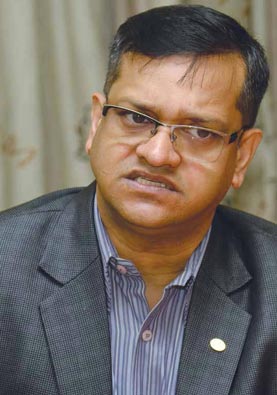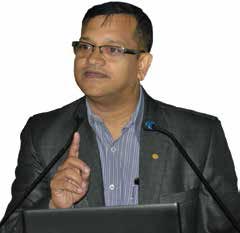
With over 20 years of experience in managing Human Resources, Clifford Mohan Pai — GPHR, Associate Vice President, HR Business Leader & Head - Employee Relations, Infosys BPO Ltd has had a rich and diverse exposure across industries. He joined Infosys BPO in 2007 and is responsible for the Business Partner - HR and Employee Relations function. His organisational structure includes a team of over 100 HR professionals. His broad responsibilities cover employee engagement, developing a strong employee value proposition, driving a culture of productivity, process excellence and building a positive and upbeat employee relations environment. He is a member of the HR Management Council of the organisation. In an exclusive interview with Corporate Citizen, Pai spoke indepth about his career, tackling attrition levels in the industry and youngsters today
I am a graduate in Sociology from Fergusson College after which I post-graduated in Labour Studies, Personal Management and Industrial Relations from the Maharashtra Institute of Labour Studies (MILS). I started my career in the service industry working with Blue Dart, Fedex, then moved to Reliance Life Sciences, worked with an FMCG company, Cadbury and then moved to the pharmaceutical industry before I joined the ITeS industry. Learning was my motive back then and today as well. I feel if you are not learning, you are not enjoying.
The challenge before today’s youth is to simplify the workplace, ensure more end-to-end processes, minimise manual intervention, and to provide a wide variety of choices to our clients. The competencies required from our youth are totally different from the days of the past. Seeing and understanding change and proactively acting is important to influence the change. Aligning to the business requires understanding the business and adding value to it. HR will have a seat at the table with the business only when it can impact the business. Today HR is in the boardroom because it can add value. There are lots of HR professionals today who are driving businesses.
Attrition will continue to exist due to the aspirations of our youth. A certain percentage of attrition is healthy, a bit of churn is required. Compensation is just one part of the reason for attrition. Employee engagement is very important to combat attrition. We have a target to connect to 10,000 employees per month—not just digitally but physically. Leaders are walking the talk and connecting, engaging, and ensuring that their teams are able to see a future, growth and learning. I have stuck on with my present company for nine years because of the learning I get.
Infosys has created a smart city in Mysuru, where at one go they have the potential to train and house more than 15, 000 employees. With an investment of over $184 million, this smart city grooms Infosys’ talent. This is a global education centre which is spread over a 335-acre campus and ranked as the best in the world for education and training. To top it all, Infosys has Infy Bubble, Infy TV, Infy Chats, and its own way of using social media to communicate and get feedback from employees.
Youngsters today are perceived to be individualistic rather than collaborative in their approach. They need to do things differently, find ways to relax, to think differently, minimise manual processes, be agile, be flexible, and simplify the workplace to ensure improved collaboration. We should be comfortable with allowing our professionals to work from home or restaurants, encouraging freelancers, evaluate performance management systems so that the right kind of feedback is provided to the team. It eventually boils down to keep learning and innovating at the workplace. We need to understand and challenge our comfort zone, as true magic happens when you challenge the status quo.
As an HR professional, when a student comes out of college, I don’t expect him/her to have a lot of practical knowledge. The least I expect them to know is to have the basics of their theoretical knowledge right. Do they know their theories thoroughly enough to make them applicable at work? I look at a balance of theory and practice and also how flexible they are in moving across functions, geographies, carrying a positive attitude.
Be hungry for learning, challenge yourself, think out of the box because if you are not doing that somebody else will and will take away your job. We need to stay updated and upgraded.
Attrition will continue to exist due to the aspirations of our youth. A certain percentage of attrition is healthy, a bit of churn is required. Compensation is just one part of the reason for attrition. Employee engagement is very important to combat attrition
If you enjoy your work, you find the balance automatically. If you are passionate your job, you will enjoy it. You can strike a balance once there is enjoyment in the work you are doing. Music is my idea of relaxation. I drive for about an hour daily but I don’t find it hard, as I have music at hand. There might not be time to read but one can always listen to audio books.

Pai’s focus during the session was on developments in technology and what we could be taking from it. He said, “The reality of the world today is that human beings are becoming like computers and robots and we are trying to put a human element in the robots of today and tomorrow.” No doubt machines are taking over the world. They are sensing the environment, supplementing human jobs and reducing the cost of operations. For example, Philips sells LED bulbs but they aren’t talking about LED bulbs. Instead, they talk about selling ‘light’ to the world. “I hear that Philips Global has got a digital panel which tells a technician which bulb is inefficient in the city and in which part of the city. This technology helps not only save cost but also time. Today, sitting in Pune you can switch on the lights of your house in the Netherlands to prevent a robbery there. The time is not very far when we would find refrigerators sending messages to grocery stores and the grocery store delivering vegetables to you at your balcony through a drone.”
“The future of digital technology is bright. Recent research tells us that the digital business of the future will require 50 percent software professionals by 2018. However, the business of tomorrow will also have 500 percent more digital jobs available. While new-technology jobs will increase by fivefold, we will require a different business model, a new technology, a new set of skills and competencies to survive. It’s not only about the IT industry but also about non-IT industries. Traditional IT roles such as tester, programmer will be automated. Folks will have to upskill to work with smart engineering technologies which are not taught in engineering schools today. In Europe alone the gap between the skills required versus expectations will cause a shortage of about 90,000 IT professionals by 2020.”
He further added, “In the near future, we will see head-to-toe wearable technology coming in. The shirt will have conductive thread with a computer built into the fabric which will provide processing power for all other wearable gadgets.
We already have the Fitbit that can sense and track all movement to determine the number of steps taken through the day and monitor sleep through the night.
Trousers will soon be made of conductive thread which would measure movement and power gadgets. We already have wristwatches which vibrate with a message and tell the time. In future, technology will have the potential to have a chip underneath the skin that would maintain all sorts of data, from medical reports to fast food data to creditors’ reports and information can be transferred to any other gadget just by waving the hand. We already have technology available where shoes contain a GPS chip providing directions using LED lights.
Research has already begun to develop an electric shaver that can capture body data when a guy starts using the shaver on his skin. A very recent newspaper article spoke about our very own Indian government thinking of bringing this technology into the country."
The reality of the world today is that human beings are becoming like computers and robots and we are trying to put a human element in the robots of today and tomorrow
‘SMAC’ i.e. Social Media, Mobility, Analytics and Cloud Computing, are areas where the social media platform has provided businesses with new ways to reach and interact with customers, while mobile technologies have changed the way people communicate, shop and work. Analytics allow businesses to understand how, when and where people consume certain goods and services and cloud computing provides a new way to access technology and the data a business needs, to quickly respond to changing markets and solve business problems.
While each of the four technologies can impact a business individually, their convergence is proving to be a disruptive force that is creating an entirely new business model for service providers.
At a recent conclave, Clifford Mohan Pai, said, “You cannot afford to achieve the same result that you achieved yesterday. And if you need to achieve a different result tomorrow, you need to think differently in order to exceed.” He enlightened the audience with a statement by Jack Welch, “Globalisation has changed us into a company that searches the world, not just to sell or to source, but to find Intellectual Capital”. This statement truly reminds him about how Palo Alto and Stanford University are coming out to be the hub of innovation, design thinking
Digital technology has been changing our personal as well as our professional world. It has its advantages and disadvantages. One of the major disadvantages is cyber threat. It is one of the major challenges the world is facing today. Cyber attacks could be a possible reason why trading was stopped on the US stock exchange sometime back.
The repercussions of the Internet being down just for a day could be serious and would lead to 196 billion emails waiting in our outboxes, 12 billion Facebook and YouTube videos not being seen and 900 million tweets waiting. However, there are positives to it too. We see huge support to Digital India through social networking sites. Digital India is all about bringing the power of the Internet to the betterment of India.”
“Nevertheless, how much ever digitisation happens, the human angle will never be compromised,” Pai further added.
By Puja Patil and
Mahalakshmi Hariharan